August 9, 2010. San Diego, California, USA
Questions and e-Mail interview by Bob Green
1. Surfing was far from a mainstream activity in the late 1940s – how did you first become involved in surfing?
The Elwell's came from England with a mixture of Scottish, Irish,
Scandinavian, Roman, and Iberian blood lines. There seems to be some
Flemish ties to the wool guilds and later to the iron business. Robert
Elwell was an early immigrant, shortly after the Mayflower, and was in
"servitude to the King" as the Elwell's were outspoken against taxes
and for religious freedom. He landed and stayed in Gloucester and
started generations of fishermen and whalers, and sailors for the
military. I owe my interest and background to the sea to my ancestors.
Most illustrious was Issac Elwell who fought on the ship Old Ironsides,
the Constitution, and other ships during the War of 1812, across the
seas to fight the Barbary Coast Pirates. He returned and retired to
Gloucester as a fisherman.
Although direct lines are from the original Elwell's, my father was
born in Boston, but brought up on the beaches of Rye, New Hampshire, and
enlisted in the Navy at age 16 in 1916. He made a career in the Navy and
travelled the world for over 30 years spanning two world wars. My
father was a swimmer and amateur photographer, a voracious reader with
time on long voyages to read books. He collected photos and articles of
his travels. He was in the first Naval Squadron to France in 1917, and
cruised the Mediterranean, South Pacific and Asia in the 1920's. He
visited Hawaii and picked up body surfing and some classic surf post
cards. He swam every day in the surf when he was home and took me
along.
|
|
John Elwell - a life spent on, in or under
the water. Photo courtesy John Elwell.
|
Body surfing was jumping in the soup, holding your breath, with your
arms outstretched. It was in the late 1930s, I remember seeing some big
surfboards and paddle boards. I can remember sometimes seeing an
ironing board being used by kids in the soup [ridden prone]. Not really
knowing then what I know now, no one understood anything about waves,
the science of swimming and surfing. My father said when he was in
Hawaii in the 1920s, he was told that surfing was a skill that
Hawaiians were born with and others did not have. Beach boys were
telling tourists that they were from Royal Hawaiians. I marvelled as a
little boy looking at the photos of surfing like it was a miracle!
It
was also a struggle to swim against waves and currents in the ocean.
Those who travelled on the sea had fearsome stories of drownings,
shark, and deadly stinger (jelly fish) attacks. Still those that lived
around the sea flocked to the beaches and loved it. Beach cultures
appeared who loved sun, water, fishing, living on the seashore.
The most remarkable change came from swim fins for body surfing and
belly boarding. Surfboards were only for big men who could carry
over-sized pieces of heavy wood, shaped like ships. Usually these
watermen
had early paddle boards for rescues but found they were too heavy and
not reliable for surf rescues. Dories were used by the Coast Guard and
lifeguards. Only after George Freeth, the Irish Hawaiian, came to the
California coast in the 1900s, after some terrible and repeated beach
drownings in heavy surf, did life saving equipment and organization
help the situation inspired by Freeth.
It was the Italians during WW II and the legendary X Flotilla of
underwater commandos with rubber suits, fins, breathing apparatus that
brought nations to organize elite athletes who became assault swimmers.
Rubber molding for fins and masks, and finally superior rubber suits
allowed swimmers more access and freedom in shallow waters. I know
Pirelli in Italy was developing specialized water equipment, and know
Owen Churchill developed some fins after seeing Tahitians in the
1930s, doing oyster diving with palm frond woven fins with carved
coconut eye pieces with glass.
After WWII the fins and rubber masks hit the market for the public.
Skin diving and body surfing soared in popularity, along with spear
guns. During the war there was a great surge in research on developing
high speed boats and no one knew exactly how they worked as it was a
new naval science to plane on the water. Lindsay Lord, an MIT naval
architect, took the lead during the prohibition of alcohol in designing high
speed load carrying boats for rum running from Cuba. He was
commissioned as an officer to design high speed military boats that
could get up fast and go with maneuverability. He was sent to Hawaii
and he began to experiment with simple plates resembling high aspect
ratio body boards. A lot of new data never before known was discovered
with a remarkable new engineering device called the Simmons Electric
Strain gage, that measured minute degrees of resistance in tested
hulls.
The gage was invented by Dewey Simmons, Robert Simmons's brother, both
brilliant students at CALTECH in Pasadena. Bob would eventually be a
surfer and would use Lord's work with the strain gage, combined with
Walter Munk's pioneering wave research studies, to build a better
surfboard he defined as a "hydrodynamic planing hull."
John Elwell presenting 'The Simmons Effect' at the Surfing Heritage Foundation, July 2010. Photo: Ben Siegfried.
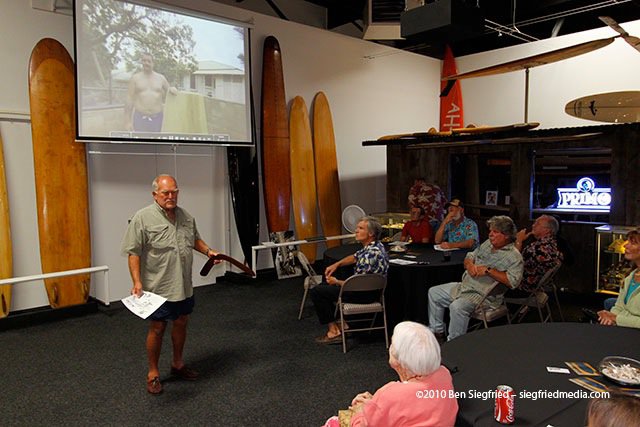
2. How and when did you first meet Bob Simmons?
During WWII surfing just about all but ceased. Able bodied men were
called into the armed services, except for those exempt or disabled.
The beaches were left to a few kids and were mostly vacant. My age
group which included Pat Curren and others, were just too young to go
into the military for WWII, but would not miss the Korean War.
During
this time we hung out at a military beach next to Coronado, North
Island Naval Air Station, that had a pool above a beach that had a
window of wave swell directly south. It used to get huge and dangerous
only in a crescent of two hundred yards. On this beach they had
military personnel who were lifeguards and they had some big paddle
boards they did not use. In fact they were useless big heavy boxes of
air, that leaked and had drain plugs, of Tom Blake design.
At
the pool we were considered "pool rats," deeply tanned spending our time
between the beach and pool. The lifeguard was a surfer named "Storm
Surf Dick Taylor," who told us surf stories and showed his photos of
the Point Loma and Mission Beach early surfboard culture, while sipping
beer in a paper cup while on duty.
He
really stoked us and we headed for the beach and asked the guards if we
could borrow their "kook box" paddle boards and they did. After a few
minutes they would leak and when you tried to paddle into even a little
wave the water would rush to nose and it would bury then hit the bottom
and bounce back up overhead. We would go off the back end and cover our
head with both arms under water and could hear the impact of these near
100 pound boards. That was dangerous and discouraging.
We
went back to the pool and told Storm Surf that we were doing something
wrong and asked if he would come down to the beach and watch us. His
eyes got very big and he said.... "You are not trying to surf those
things down there!" Then explained that there were special rolling wave
breaks like Sunset Cliffs and San Onofre. This was in 1946. He also
said down at the end of the Silver Strand was a San Diego County
Lifeguard friend by the name of Dempsey Holder who became legendary (a
pioneer surfer surfing the mile long winter ocean break at the Tijuana
Sloughs), which we did and we were lucky to have Dempsey's guidance and
assistance, shortly after that Bob Simmons showed up on the scene with
the first modern high performance surfboards.
Up
to this point we borrowed and shared very poor heavy boards and
struggled. It was trips to San Onofre and Windansea that really turned
us on and we met some older mentors who were superior water men and
gentlemen who helped struggling kids. The life style was very appealing
and addictive. They had bonfires at night, played ukelele's, cooked,
had late night drinking parties and beautiful women they would curl up
in the sand with them in their sleeping bags.
A
few old timers came back after the war to the beaches. Many did not or
were killed. A new breed of youngsters showed up that were hot and
eager. Simmons took many of them surfing before they learned how to
drive like Buzzy Trent, Peter Cole, Matt Kivlin, Greg Noll, Kit Horn
and others. Velzy also was allowed into Simmons' shop to chat and work
together. Simmons helped kids and set a precedent of helping the next
generation of surfers. Bob Simmons was an impressive person. Casually
dressed would be speaking mildly. Simmons cared not for bathing except
for surfing. He wore a wool plaid jacket, or wool flannel shirts that
were covered in fiberglass dust and resin. Never wore underwear and
socks. Would eat seed gruel cereal when at home and fresh fruits. On
the road he would eat can soya beans and fruit and sleep in the back of
his car, which had boomerangs and oceanographic charts. He carried an
adze and some tools for shaping. He would also eat cottage cheese and
loved sherbet ice cream. He was an avid boomerang thrower and ping pong
player. Extra time was spent at the Scripps Institute of Oceanography
studying wave research.
La Jolla January 9, 1954, the day towering waves of 20 feet or more
battered the coast of California. Simmons had just come back from the
North Shore of Hawaii. The photo below shows his 1937 Ford Tudor, with a 60hp V8, back windows darkened for privacy, back seat gutted out with a
plywood deck into the trunk which had a sleeping bag. The passenger
seat was removed for leg room when sleeping and a wooden milk crate was
used if there was a passenger. Canned soya beans and usually a
boomerang or two were in handy reach. Note his bathing suit drying on
the front bumper to be ready for the next surfing stop.
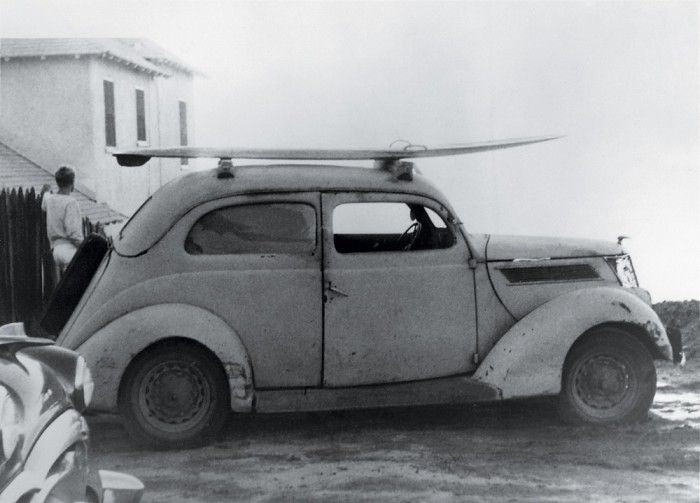
Photo by John
Elwell.
The surfboard is one of the most unusual ever made and has vanished.
It has flow slots in the nose, and near the tail to direct resistant
water along the rail then direct it off the rail. This board was an
incredibly fast paddler and was for big waves. He cackled a laugh and
said you don't go any faster if one of those slots catch on a slow wave
turning. The board was designed and built in 1949. It also had a
concave bottom and dual fins. In this photo you can see the rope
handles to roll through giant soup. The rack is custom made from two
pieces of 2x4's. The color is primer gray. The photo is rare because it
is the only one of his car with this surfboard, his favorite big wave
board. He further added that the nose is sticking out of the water when
it surfs AND that blew away any criticism about the nose. In fact the
belly or cambered nose directs the water to rails to increase faster
lift and planing briefly for an advantage AND if it comes in contact
with the water such as chop it "lifts" and does not slap like a flat
nose. More turn up solved the problem of pearling and nose diving. The
thinner tail also helped to bring up the nose when you stepped back on
it. But it was the rails that Simmons said were really surfing on,
combined with high aspect ratio, and reasonable weight with proper
flotation for load, the rider. Simple but complex in achieving the
whole.... a well balanced planing hull that is fast and maneuverable.
Tom Carlin is at the left watching the big waves. Tom was a
lifeguard who became a Navy Seal and did a number of underwater films
in the Caribbean, including the James Bond thriller, Thunderball. He still has his
original Simmons and is a retired professional diver. Tom was great
surf character and known world-wide for his antics. A good surfer and
of course and all round waterman. Simmons
was older and handicapped from a bicycle accident and his diet was
because he had leg cancer and was threatened with amputation. He was
declared unfit for the war because of his limited use of a broken arm
in a bicycle crash. When the war started he quit CALTECH in his last
semester of his senior year and became an expert machinist working at
night so he could surf days. He then was hired at Douglas Aircraft as a
highly valued mathematician in aircraft design, but often called in to
say he had to quit because the surf was up. Company officials, the CEO
of Douglas was a San Onofre surfer, replied to come back after the surf
went down! Simmons died being employed at Leiberscope a top secret
aerospace lab in Los Angeles where other bright CALTECH former students
worked. Howard Hughes also attended CALTECH and students from there
were also favored in his company.
Kit Horn (left), Bob Simmons (middle), and Buzzy Trent (right),
Malibu, Ca. 1946. Simmons is quite thin in this photo. He was 6'1" tall
and developed more shoulder strength and size with powerful thigh
muscles from bicycling the following few years.
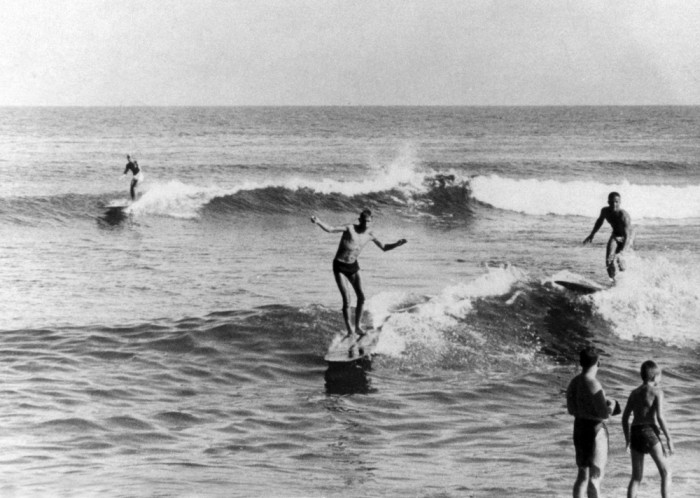
Photo courtesy of the John
Elwell Collection (photo by a friend of Kit Horn with Kit's camera).
Simmons
was a motivating force among the better surfers in his time. He was
known to surf the most and biggest waves. No one really understood his
surf board designs even though he left the basic clues of "hydro
dynamic planing hulls." Before his death he surfed the North Shore
sometimes alone. He praised Banzai Beach which he rode in 1953 as
having "real possibilities". He told the local surfers at Makaha,
riding the bowl instead of the point, that they were "shoulder hugging
chicken". Such was Simmons, as he offended some, was admired by most,
and surfing the point of Makaha became the choice of the best surfers.
Bob Simmons surfing Big Malibu, 1947.
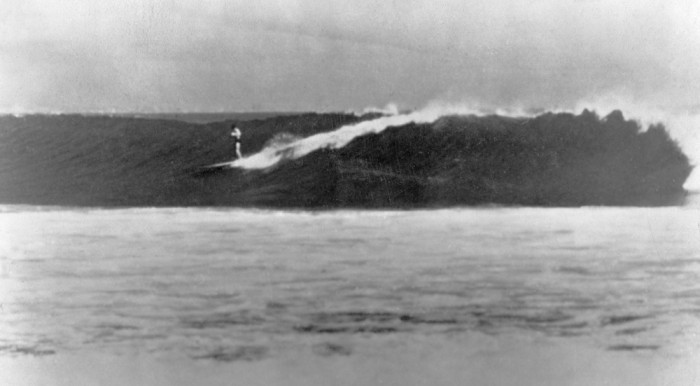
This is a rare photo supposedly
taken by Bob Prosser, unknown and long gone, thought to be a Hollywood
porn photographer who just came along that day. It is the biggest wave
ever photographed with any rider getting in so early demonstrating
great speed not before seen. It is unusual to see Simmons with his feet
together and looking down and evaluating his trim balance. Not unusual
for Simmons. He later gave Simmons copies of this photo which Simmons
was very proud of. He gave personally gave me this copy as his friend.
The ride and size of the wave has not been replicated to this day.
Note: not another surfer can be seen, nor could they surf anything like
this on the old planks and paddle boards.
Photo courtesy of the John Elwell
Collection.
3.
Some surfers take a very systemic, scientific type approach to what
they do – be it weather, design or surfing. What was Bob Simmons
approach to developing designs?
Bob Simmons was an expert in boomerang history and construction and a
master of Daniel Bernoulli's Law or principle that describes how things
fly and plane on the water. Bob was also a ranked champion ping pong
player, who applied Bernoulli's principle by putting a spin on the ball
with a gripping surface on the paddle. No one really understood Simmons
as he was too far ahead of his time, and intellectually out of touch
with the average person. He travelled and surfed mostly alone and
constructed surf boards mainly in secrecy, mass producing some and
refusing to do the dirty work of sanding and glassing. Some radical
things appeared on his boards like twin fins, concave bottoms,
increased rise in the nose that had camber, foiled rails, with a final
product that was balanced with a designed "attack angle". This and
fiberglass, foam, and resin flow slotted noses were just too much to
swallow in the late 1940's. Pieces of this whole would be copied to the
Malibu board and carried through to surfboards today without fully
understanding what it was about. Simmons also could make surfboards
exactly float the rider or load by using Archimedes equation or law for
displacement. This is still ignored today. He never gave up on "high
aspect ratio" hulls, maintained width, and maintained different degrees
of roundness on high pressure Bernoulli rails.
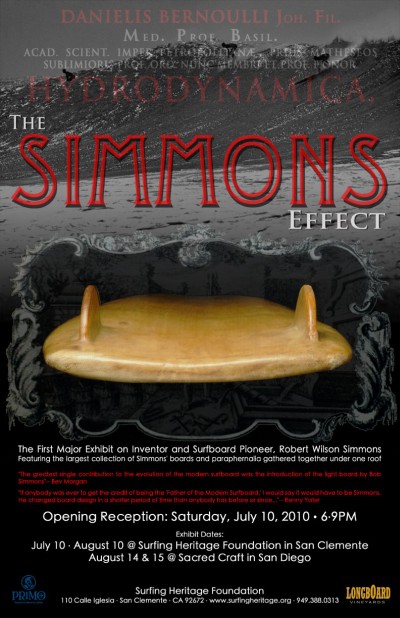 |
|
Poster for 'The Simmons Effect' presentation held at the Surfing
Heritage Foundation.
Caption by John
Elwell: "It provides a great view of a board. This figure shows his concave
and dual fins. He says the concave was to break the suction and fins
were set at the rear of the board toed in 10 degrees in the flow of the
water being spead coming off the hull, which is at an angle called
"Transpan Flow."
Note the degree in thinness of the tail which took a
great deal of weight out of surfboards with the rounded Bernouilli
rail for life. The thinner tail induced a better attack angle which
was previously ignored in all surfboards and are copied today with rounded
rails. Bob was adamant that we're surfing on our rails and going almost
as fast sideways as forward.... on these points he designed surfboards
with a few more things as part of the whole."
Photo courtesy of Barry Haun, Surfing Heritage Foundation.
|
|
4.
Surfboard designs come and go. I’ve read that you stayed with Simmons’
design ideas and developed them over your lifetime. What interested you
about Bob and his boards?
Simmons
was not into mass producing surfboards or money. His language was
mathematics and the world was all science. He died at 36 years old at
Windansea, after surfing Hawaii, doing a late take off and slipped on a
poorly waxed new board, one he called "my latest machine." Think about
this. Are surfboards simple machines that produce work like the
Bernoulli's equation suggests?
Tom's Carlin's 9-foot Simmon's made in 1951, photographed in 1985,
after it was refinished. This photograph represents a board without a
rider (Simmons death) with a sun beam of light signifying the first
modern hydrodynamic surfboard. It has not been retouched and is an
actual photo taken into the sun.
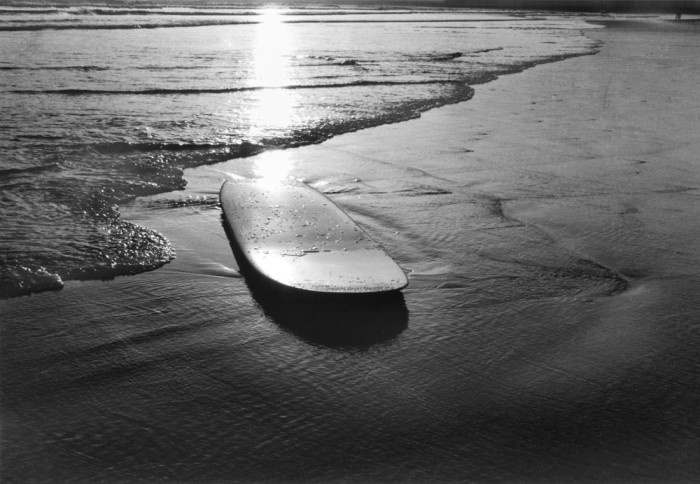
Photo by John Elwell.
After
Simmons death we surfed all the other surf boards that came out. It is
interesting to compare the similarities and what others said. Joe Quigg
said, "I copied his rails." Hobie Alter said, "I copied his boards."
Noses and tails changed but similar rails remained. Simmons himself
said bluntly that it did not make much difference changing the nose and
tail, "because we are surfing on our rails! " He said you don't need
much fin and said big fins could really get you into trouble. If you
want to keep your surfboard, put two coats of glass on it and paint
with a special fiberglass paint because the sun will destroy it. "These
boards are really easy to make and can be built in any garage."
Much
time has passed since Simmons and there has been a retake on his
designs and the basis for them. Richard Kenvin one of the finest
surfers in the world started to dig up and revisit Daniel Bernoulli,
Lindsay Lord's early material and started to recreate the small version
of the Simmons boards. They have found them exceptionally fast and
manoeuvrable. Joe Curren told me it was the fastest board he has ever
ridden. So it appears Simmons was on to something. His boards were
copied to the favorite Malibu board, the Hobie's and others. The foiled
hydrodynamic rail remains the most visible part and other parts have
been modified.
It is fair to note what Lindsay Lord said about planing hulls: a lot of things work and every change is a compromise.
John Elwell and the "Lord Board" at the Surfing Heritage Foundation, July 2010. The board
is called a "Lord Board" because it was drived from a 1940s photo and study by Lindsay
Lord (see below).
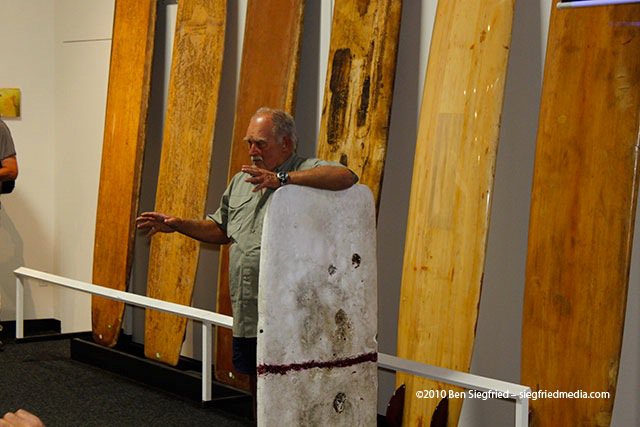
Photo: Ben Siegfried.
5. Can you explain what you understand by the term "hydrodynamic planning hulls" and how they work on a surfboard?
There
are books and pages of complex equations and theories on hydrodynamics.
Surfboard planing hulls would have to have an adequate aspect ratio
(width and length) with proper distribution of weight for load and
attack angle, some turn up on the nose, with some type of foiled
rounded leading edge. This would be to lower the pressure on the top
rail and increase the pressure on the bottom rail to get dynamic lift.
Any design or design changes should be tested with an electric strain
gage available at engineering supplies that are now available to do
three dimensional stress resistance tests.
6.
In an e-mail you mentioned that Simmons did not make bellyboards
himself. If you were to design and construct a paipo/bellyboard today
what would it look like?
Probably
a body board paipo designed by Simmons would have a very thin but foiled rail,
some concave, maybe tiny fins and look like a mild version with turn up
on the nose with camber and a little belly. It would be high aspect
ratio..... wide of course.
7. Have you done much bellyboarding (e.g., riding prone)? What types of bellyboards have you ridden and when/where was this?
I
rode belly boards from time to time, more so when I lost my hearing and
balance. These belly boards were stock pop outs. Those with rocker did
not work well. I thought pop out plastic ones had poor rail design and
were for the general public. We have some fine belly boarders in the
area and the custom boards I see are far better. Some other good stand
up surfers who got older also became good belly boarders. Stand up
surfers and body surfers with experience have experience in bigger
surf. It became obvious that fins were not essential for belly boards
and a good hydrodynamic rail could track well in a steep wave.
I
always have them around because the grand kids love them and all
surfers should learn on them. It was watching Greenough on film that it
was apparent that riding prone reduced air body resistance, and his
body weight added more pound per square inch of pressure on the hull.
Greenough and others get higher pressure on the rails with their arms
and weight on the inside rail and can trim more precisely. This is the
answer to increased speed belly boarders have, if they have a superior
board. Increased inside rail pressure gives more dynamic lift. A good
example is stand up board riders reaching under the outside rail and
lifting it up as a lever to get a spurt more speed on the inside rail.
The body boarder has a distinct advantage of having more control. The
disadvantage is getting up to speed for a take off because his plate
has less resurgence that a longer more high aspect ratio plate.
Our
place for belly boarding is North Beach during south swells that become
too powerful for most board riding and rides end up in collapsing
tunnels at low tide. The rides end up in crushing violent maelstroms
sometimes injuring riders seriously. A few have end up paraplegic.
Accidents do happen to the best in any sport... mountain climbers have a
saying about being too bold, and pushing the envelope too far.
You
noted: "Greenough and others get higher pressure on the rails with
their arms and weight on the inside rail and can trim more precisely."
This is an interesting observation because, John Waidelich in Hawaii
and the guys who rode small ply bellyboards in Australia rode with
their inside arm outstretched. Unlike Greenough, these guys were lying
prone, but they were obviously putting pressure on their inside rail,
especially when dropping down the wave face. Unlike the refined rails
you have been describing the rails on these bellyboards were usually
hard edges, only 3/8" thick. The other technique on sub-4' boards was
to be poised right over the front of the board, legs out of the water,
reducing the wetted area and drag. Any further comment on this style of
surfing?
Weight
forward and lift aft is necessary for air planing and hydro planing.
Plywood rails are not as thick but work with similarity, but not as
efficient as a true foil. Keep in mind again of the number of variables
and complexities of planing. The only observation of Bernouilli is that
regardless how thick it is, that it is rounded. Most rails are rounded
for safety. Real Bernouilli is rounded more down from the top. The
action is from deflection and pressure from the down rail. Lifting the
outside rail like a lever to transfer appropriate pressure to the
inside rail is what gives the "transpan" flow. All these things are
parts of a complex whole.
Width
of the plate maintains the deflection pressure for a sudden dynamic
release. Lord says good planing hulls adjust themselves to the speed.
In fact as we all know they will sometimes leave the water and skip. It
is difficult to summarize all the complexities and variables in all the
parts of the whole.
We
should note that body boarders adjust their weight for the take off
attack angle and desired trim like all surfers. Body surfers very much
extend arms and lean forward. I believe a taller body surf rider with
fins may have an advantage for initial lift.
Approximately what year or time period were you losing your hearing/balance?
Losing
hearing was progressive. Cold water does it and also loud noises. I was
exposed to gun fire and loud submarine diesel engines, plus vacuums and
pressures inside the submarine because we had "a snorkel." By age 40,
old my hearing loss was more progressive and by 60, I was wearing
hearing aides and frequently unbalanced. John Kelly of Hawaii, now
deceased, and others who were very fine early surfers experienced the
same physical malady of loosing their hearing and balance and returned
to body boarding in their declining years. I maintained surfing until
it became dangerous.
Jim
Voit, a former lifeguard friend of mine, good surfer, and once an
all-around athlete became very serious in his 60s in body boarding. Jim
had always been an excellent body surfer and powerful swimmer. He is
now 80, as I am also, and we have tapered off surf activity but put
daily
time in lap swimming waiting for warmer temps. This summer we have had
many days in the 50s that hurt the whole body without a wet suit.
Numerous youngsters and people who cannot afford surfboards become good
body boarders, then seem to fade away into adult life of work and
family.
8. Do you see any links being bodysurfing technique and bellyboarding?
Of
course. Judgment from practice. The belly board reduces drag and has
more rail to get the Bernoulli effect. I might add that belly boarders
are doing more spectacular moves and doing more than ever. The sport
has been greatly improved by style and equipment. We have some elite
hand gun surfers who do some impressive stuff.
Can you explain what you mean by the Bernouli effect?
Bernoulli
says if you raise the pressure on the down rail and reduce it on the
top you will get lift and roundness helps on the leading edge like a
wing. Weight helps as does gravity and the wave itself as it starts to
break in shallow water. The plate (or board) is controlled by the rider
by deflection changing the kinetic energy. Everything comes into play
of many parts to a whole.
Bernoulli
has been improved on by others. Magnus is another person who became
concerned with trailing water and air that caused suction as it left
the hull. Why good sport cars have spoilers. Lord says a good wake
should be overlapping outward and not inward. Wide hulls with
contiguous rails seem to deliver the best wake (parallel) as Lord
photographed and tested. Like the Ryan Burch copy of Lord's model in
the 1940s (see Note 1).
Naval Architecture of Planing Hulls by Lindsay Lord.
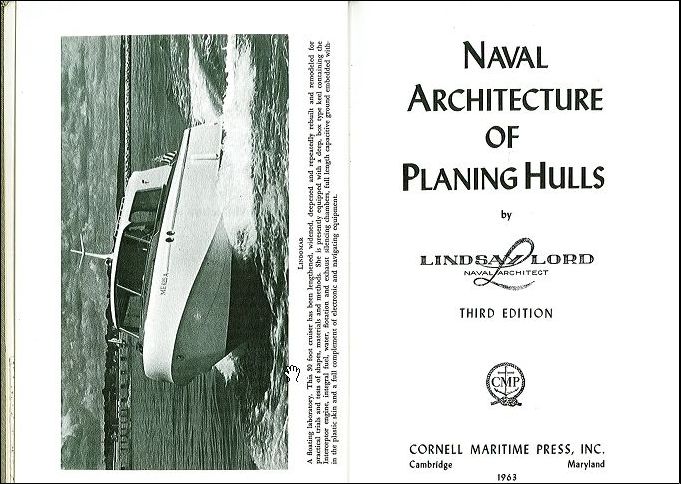
The inspiration for the Lord board.
|
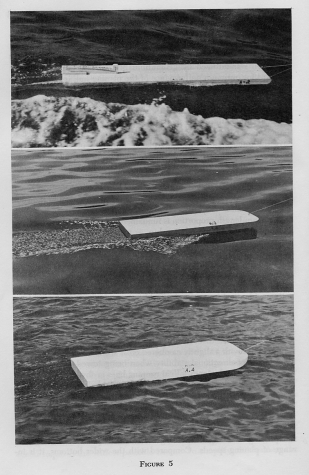
|
|
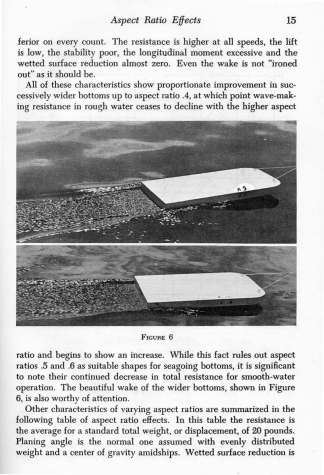
|
Source: Lord, Lindsay. 1963. Naval architecture of planing hulls. Cambridge, Md: Cornell Maritime Press., pages 14-15. See an annotated summary of the book here.
9. In an e-mail you mentioned seeing Wally Froiseth ride a paipo standing-up, with swim fins on, around 1957, at Makaha.
Wally
was impressive. He was right in with board surfers at Makaha. Stand up
rides were on modest size waves, but it was startling to see a grown man on a
small plate stand-up. Pat Curren jokingly said, "When it gets 20 feet
Wally then switches to his surfboard." Of course, Wally was an expert
and had been doing this when he was a kid. He was in superb physical
condition and a master of wave judgement.
With
Wally's stand-up paipo riding was he emulating the more straight-line
trimming longboard style or was it a more short-arc turning style?
There
is not much room on a body board especially with fins on. He stood up
with perfect trim and astonished all around him. Everyone knew who he
was and gave him plenty of room. I would say after all these years he
was the most outstanding rider I had ever seen. Remember he was part
of a group who were almost as equally good like George Downing, but
George by observation stayed more with surfboards and that small group
of excellent water men were regular all around surfers since boyhood
until they got too old. Who did this stuff as kids in the 30s and
40s.
10. Are there any other paipo/bellyboard riders that you recall?
They
were around in Hawaii but mostly kids. We had some impressive skim
boarders especially around Laguna Beach. Skim boards of course work on
the same principle and plane on a film of water.
The best ones would skim out to the back wash and get air. Very
impressive.
Some good paipo/belly boarders have emerged around Windansea in the
south shorebreak. Most surfers do not want them in the way in the
regular break when it gets crowded.
There is a whole new wave of paipo riders and belly boarders. That
would take some research along the beaches. They are extremely good and
very serious. Pop out boards seem in rare cases are getting better rail
shapes, but the hard core riders who make their own are performing
better. I have met some who made boards some years ago. It is a
completely different sub culture to surfing.
11. How and when did you become involved in the Hydrodynamica project? What has been your role in this project?
Seven
years ago Richard Kenvin contacted me at the Windansea Reunion about my
article "The Enigma of Simmons," published in 1995 (see below). We had several
discussions and I shared my research materials on The Naval
Architecture of Planing Hulls, Daniel Bernoulli, Boomerangs,
Archimedes, with Simmons' comments and surfboard designs that were all
linked together.
Richard Kenvin Mini-Simmons, ca. 2007. Photo courtesy of Richard Kenvin.
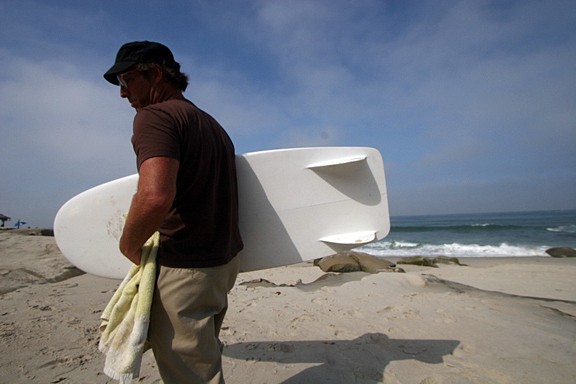
Mini-Simmons, ca. 2007. Photo courtesy of Richard Kenvin.
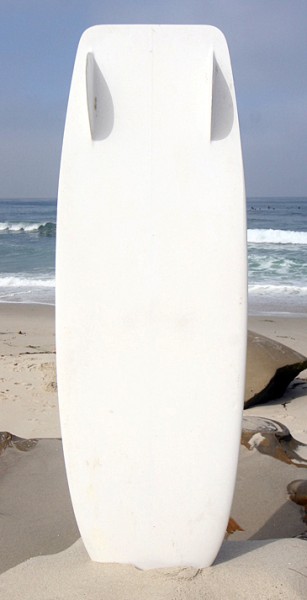
Richard Kenvin Mini-Simmons, ca. 2007. Photos courtesy Richard Kenvin.
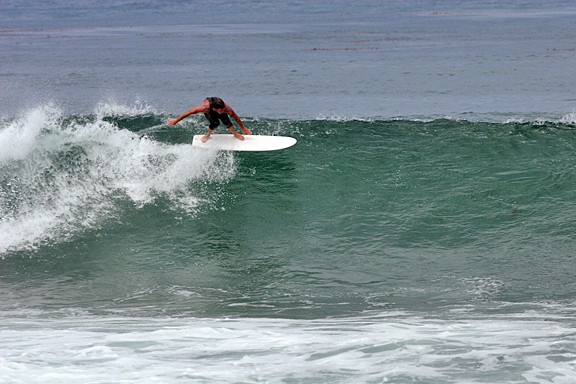
Richard Kenvin Mini-Simmons, ca. 2007. Photo courtesy of Richard Kenvin.
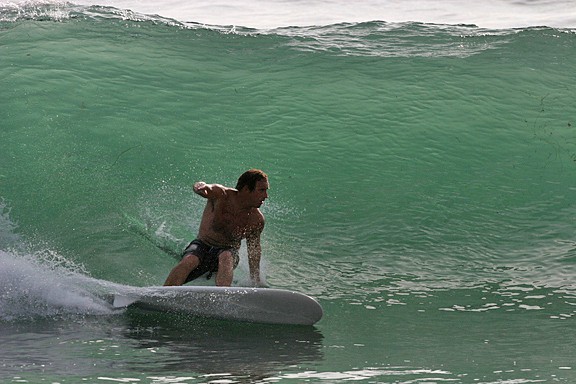
He
has carefully evaluated the pieces of the Simmons enigma, interviewed
many of my sources, read and researched, and became immersed in this
story of hydrodynamic planing hulls. He had decided that this was
indeed a very unusual and untold story. He then has done several
stories with photography, and filming to make a movie in progress.
Richard has identified me as project director because of the initial
research I did and I have given my full cooperation to the
Hydrodynamica project. "Hydrodynamica" has been copyrighted for the
movie and book.
The
aim of the project is to follow Simmons, an amazing man and the amazing
story on his development of surfboards to bring awareness of the
science to educate surfers about planing hulls. Richard then recreated
replicas of my original Simmons board and tested them with his elated
friends and sold a couple of hundred to start a successful business.
Several other surfboard makers have come on board and have mutually
agreed that the general concepts are superior (see Note 2). There has been international acceptance and many enthusiastic followers of these hydrodynamic, superlative performing boards.
"Hydrodynamica"
is the title of Bernoulli's prizewinning paper submitted in Paris,
which was one of ten in his lifetime. It is the name of the project from
the book I am compiling on Simmons and related men and events that
links to modern surfing.
We
were very impressed with Simmons as a person and his boards. He was a
lightning bolt. He was as Jim Voit said, "A very unusual man." He was
like a passing wind. He was here and suddenly gone. There was a vacuum.
When he died there were many unanswered questions and puzzling pieces.
Digging around a bit, no one knew very much about this guy. He had a
few favorite friends. His family knew very little about his surfing
exploits.
Simmons
cared little for money, fame, and material things. There are
indications by his academic and personal life he was brilliant and a
gifted athlete who was handicapped.
The
picture was a devout surfer who made some radical boards, who also was
a championship ping pong player, expert boomerang maker and thrower,
plus a precision hatchet thrower...yes! He was a powerful endurance
cyclist. Velzy said he was so good he could have gone to the Olympics
and no one could touch him in bike sprints or distance. He had a
photographic memory. He excelled in advanced mathematics and was
employed as a precision machinist, engineer at Douglas Aircraft, and
finally at a top secret aerospace lab, Leiberscope.
I
first was puzzled by his claim that his surfboards were hydrodynamic
planing hulls. He had Lindsay Lord's book on naval architecture. The
trail began with hydrodynamic which immediately brought up Daniel
Bernoulli and his work. The next question, "did boomerangs have a
connection?" This was a big surprise as Captain Cook brought back the
first boomerangs (throwing sticks that could fly). They could not be
explained at first by the British Royal Scientific Society until one of
the group went...."Oh?....this is Bernoulli." The big bells went off! The
curve ball is the effect of Bernoulli. Bob's slice with a gripping
surface on a ping pong ball that could change direction over the net
was also Bernoulli.
I
kept poking around writing letters and talking to people. Our USA
boomerang society, who are mostly all aerospace and aerodynamic people,
told me to get Felix Hess' doctoral dissertation done in Germany, in
English, as the last word on boomerangs. I recommend this book as it is
the history of boomerangs. He tested many boomerangs in the famous
Dutch hydrodynamic tank, in Holland. From this research helicopter
rotors were improved for the military. This is startling to surfers.
Boomerangs, helicopters, and spinning spheres, all have a connection to
surfing. To understand how a surfboard works you must know Bernoulli
first then a few more pieces of a complicated whole that is still being
refined.
What is embarrassing is that surfboard makers and surfers can't tell you how a surfboards surfs. They copy things that work.
I
became more interested about ten years after Bob died when I read in
surf publications how some surfers claim to have done something special
for modern surfing and were claiming what Simmons had done without
mentioning hydrodynamics. They thought fiberglass, lightness, and foam
were the major contributors.....not form. No mention of Lord's study or
Bernoulli. Obviously no one understood what really happened. All kinds
of theories popped up and design claims, and fin claims appeared.
Things were really looking interesting and ridiculous and very contrary
to what Bob had said, and what was known by naval architecture for
planing hulls. Simmons had a few important supporters who knew all
along and were silent witnesses like Peter Cole and Reynold Yater.
Greenough knew Yater well, in Santa Barbara, and later spoke highly of
Simmons as the greatest designer of surfboards. Greenough also was
handicapped by serious heart surgery and still became a prone surfer of
outstanding ability, plus construction of successful boards, and a
award winning photographic maker.
There's more to this story and it will be part of the book on Simmons hopefully when Richard finishes his movie.
There
is also the connection to all this with Bob's brother, Dewey', and his amazing
invention of the electric strain gage used by Lord to test planing
hulls. Dr.Walter Munk at Scripps, a classmate of Bob's at CALTECH
became the world's wave expert. It all comes together for a most
different type of surfing story. All this is being revisited and the
Simmons replicas are doing a come back as extremely fast and
manoeuvrable through better hydrodynamics.
12. What impact has Bob Simmons had on your life?
Sixty
some years ago it was a struggle to surf because the boards were too
heavy and not hydrodynamic. It was an ordeal for youngsters and women
to surf. We had a very good surfer in our group who did very well in
Hawaii, and has the finest ride ever filmed at Makaha, according to Bud
Browne: Chuck Quinn one of my best friends. He summed Simmons up by
saying, "Thank God he came along when he did!" Curren said after his
death that it was too bad, "He might have come up with something better
for Waimea."
Surfboards
became dramatically faster and easy to turn after Simmons. Just after
him came the modified Malibu and other boards, surf films and surf
music and billions of dollars of surf industry.
For
me, I greatly appreciate what he did because he gave me so many good
surfing days in my life. I am indebted and because of my curiousity and
admiration for him, I have met his family, learned more of the sport to
be able to give back to it. It has been quite an education and joy.
There have been several others like yourself that have become
interested in this project.
John surfing San Onofre, 2009.
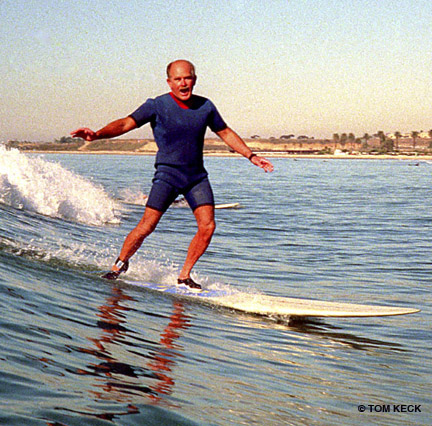
Photo courtesy of Tom Keck at http://tomkeckphotos.com/.
13. Any other thoughts on surfing or more generally?
Being
from a beach area in the times I grew up we became all around water men
who surfed as body surfers, belly boarders, surf boarders, skin divers,
and lucky enough to be around at the right time and right place as
things were really good with few people, pollution, and clean seas full
of marine life. We were all lifeguards. Things have radically changed
to better equipment and surfers riding bigger and better waves
worldwide. Motorized rescue and tow-in are now popular, but good old
fashion
water and ocean experience, with fitness, is still a high priority.
Like
others my age from diving and cold water my inner ear became affected
and I gradually lost my balance. I can still body surf and body board.
I can't dive as deep safely. My swimming instructor as a lad was eaten
by a great white shark in La Jolla in two bites. I agree with my good
and lifetime friend Pat Curren. "We were lucky to be born when we
were!" I still enjoy doing underwater photography and surf photo
hobbies.
(Right) John freediving. Photo courtesy John Elwell.
|
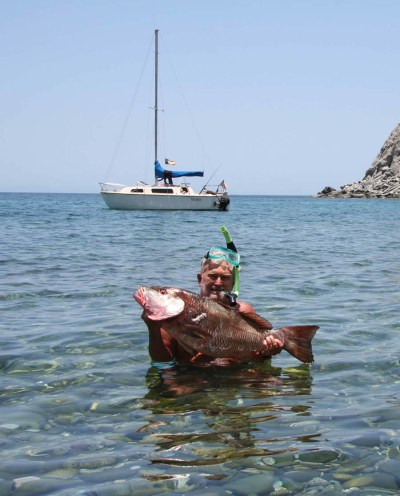
|
Follow-Up Questions, November 2010:
14.
In an e-mail you mentioned that Simmons did not make bellyboards
himself. So, the question that begs asking is: What would a
"Simmons-design paipo board" look like? For purposes of discussion
let’s assume the paipo board would be 46 to 50 inches long. How wide
would the board be (i.e., what aspect ratio would be used)? How thick
would the board be? What would the board template look like? How much
belly would there be in the nose section and where would the concave
begin? What would the rail template look like from the nose through the
tail (sample rail drawings for the forward, middle, aft and tail
sections)? How much thinness would there be in the rails? And for the
benefit of the novice paipo designer, what is meant by the "turn-up in
the nose with camber?"
One
of Simmons friends told me that took some broken Simmons boards and
used the forward several feet of the nose and they turned out to be
excellent body boards. To my knowledge Simmons did not make any body
boards, but he could have.
Keep
in mind the maximum width allowable is what fits between your shoulder
pits. That would mean it would be different for every individual,
especially for women and kids.
Remember also that displacement is calculated with Archimedes equation for the exact load.... so dimensions would vary on
thickness and actual size of the plate. Rule of thumb "generalization"
and "guestimates" would not be what engineers and naval
architects would be doing. Having said that, aspect ratio
can be calculated by dividing the length into the width. It should be
close to .5 for the ideal. Width and length will vary to load (weight
of the rider) combined with buoyancy or displacement (Archimedes
calculation).
It is the roundness of the rail which is not identified clearly. Old
stuff written says it has to do with "roundness." Simmons use
what is called soft rails for stock boards, but not for his personal
boards! His personal board had harder and more down rails, to thinner,
and some 60/40 percent. This is an open area for more exact research
and experimentation. It is very tough to measure the results. Maybe the
new strain gauges can do it with engineers in a test tank.
So what you are asking is impossible to do unless you know the load
(which is what the board will carry in weight). One also needs to
consider the flotation characteristics of the board. I understand
that foam can calculated by the number of bubbles and density for
displacement. (My son is a chemical engineer at Dow, a pioneer, and
still leader in many different types of foams that surfers don't ever
know about!)
How would I make a paipo/belly board? I would copy key characteristics of a planing hull which would include a
- high aspect ratio (wide and parallel: divide the length into the width -- it should be close to .5 for the ideal),
- smooth
uplift in the nose with "camber" (some roundness to try and capture how
the water spreads it to the rail for quicker and faster lift for take
offs),
- shallow concave to break suction, and
- foiled and rounded rail (and with more down rail).
Length
is open to what you want and where you surf. Keep in mind
"resurgence," an important part for speed in different situations. And
also what Lord said, "A good planing hull will adjust to speed." For
example, a rider will automatically adjust the attack angle (tail
squat) -- more that 20 degrees is stall and as the plate moves it comes
up and the rider gets his weight forward to get over the "hump."
My personal feeling is the paipo creation is like the surfboard... an
accident and came about from rule of thumb. The people of Oceania had
no mathematics or written language or milled flat pieces of wood until
the early western explorers arrived. When plywood veneers came out,
especially marine type, things changed. It was once guessed by Ben
Finney that the first things used by children were coconuts for
buoyancy in the shore break. I would imagine ship wreck wreckage was
used. Cutting out flat pieces with a stone adz seems awfully difficult
but apparently done. No one knows for sure because historians guess.
Wood does not last long in the elements.
One more thing that Pat Curren said and Simmons referred to, “You will
know when you have a perfect board.... then you should keep it!”
15.
Clarification on the statement, "Greenough also was handicapped by
serious heart surgery and still became a prone surfer of outstanding
ability." By prone, were you referring to his mat riding as opposed to
him kneeriding?
I
remember Greenough in early movies going like hell in Santa Barbara
prone.... lying on the board. I think he did both prone and knee, but
don't think I have ever seen a photo of him standing. He had tremendous
speed and control with his weight adjustment for pressure with more
square inches on the plate.... plus lowered his wind resistance which
stand up surfers suffer a penalty!
16. Closing Words.
This
you can get from Lord. Simmons applied it. Lord's work applies to
straight flat running. Simmons adapted the hydro foil rail for waves
which is rounded, and he changed the degrees of slope and roundness
progressively sharper to about 60 percent down to 40 percent up. This
is open to experimentation.
Simmons sarcastically use to say, "We don't need darts in surfing!"
A wise statement from Lord was, "Every change from the ideal is a compromise."
This is not rocket science but simple, plain, naval architecture of
planing hulls. The outline is parallel with a rounded nose and
fared in slightly tail, mostly a smoothed up rectangle that is wide and
with appropriate length. Tweaking the design with rounded foiled rails,
turn up with camber in th nose, and modest concave certainly looks like
these enhance performance. The jury is out on fins and is an option for
the individual rider to evaluate to his skill and waves he is riding.
The boomerang too! It was an accident. Some sticks thrown that
were found in stream beds rounded and bent or what ever when thrown
flew better than others. Those were copied.
Bernoulli described and put the effect of planing into a mathematical
formula of numbers. It has been improved on. Lord applied it to
planing hull boats and Simmons applied it to surf boards in waves. From
the evidence we have... Simmons was obsessed with Bernoulli,
probably from early experiences of being in a "flying club" which was
seriously involved in "boomerangs." All very basic in
understanding aerodynamics and hydrodynamics.
Keep me informed how you and your friends adapt this to your own
boards and riding. Thanks. I feel humble you were interested in Simmons
and this information. This is not new information and been in the
closet and is becoming more apparent to serious enthusiasts. It is not
what most have thought in surfing history.
Good luck and thanks for your good work in something we love and is so important in our lives.
Note 1. For footage of this board being surfed see http://www.korduroy.tv/2010/stranger-than-friction. See also Kenvin, Richard. (2010). Square One. Serious Fun with Linday Lord
and the Yard Possums.The Surfers Journal, 19(5), 16-27. The Hydrodynamica Totem Pole
further notes Ryan Burch's contributions, "In the late summer of 2009,
a young surfer named Ryan Burch from Encinitas deconstructed everything
when he created the “Lord Bord”, a basic chunk of unglassed foam that
he shaped into a simple finless planing board inspired by the models
used in Lindsay Lord’s “Naval Architecture of Planing Hulls.” Burch’s
hyper-creative surfing on this simple planing board is a dynamic
demonstration of how the surf/skate style ultimately has its roots in
the paipo and alaia boards of ancient Hawaii."
Note 2. In addition to Richard Kenvin, others listed on the design team include Rusty Preisendorfer, Carl Ekstrom,
Larry Gephart, Hank Warner and Daniel Thomson.
To read more of John Elwell’s work see
- Elwell, John. (1994). The Enigma of Simmons. The Surfers Journal, 3(1). Read the article here.
- Elwell, John, and Jane Schmauss. 2007. Surfing in San Diego. Charleston, SC: Arcadia Pub.
- Hydrodynamica project. (Click here to read more above the Hydrodynamica project and related publications.)
|
|
|